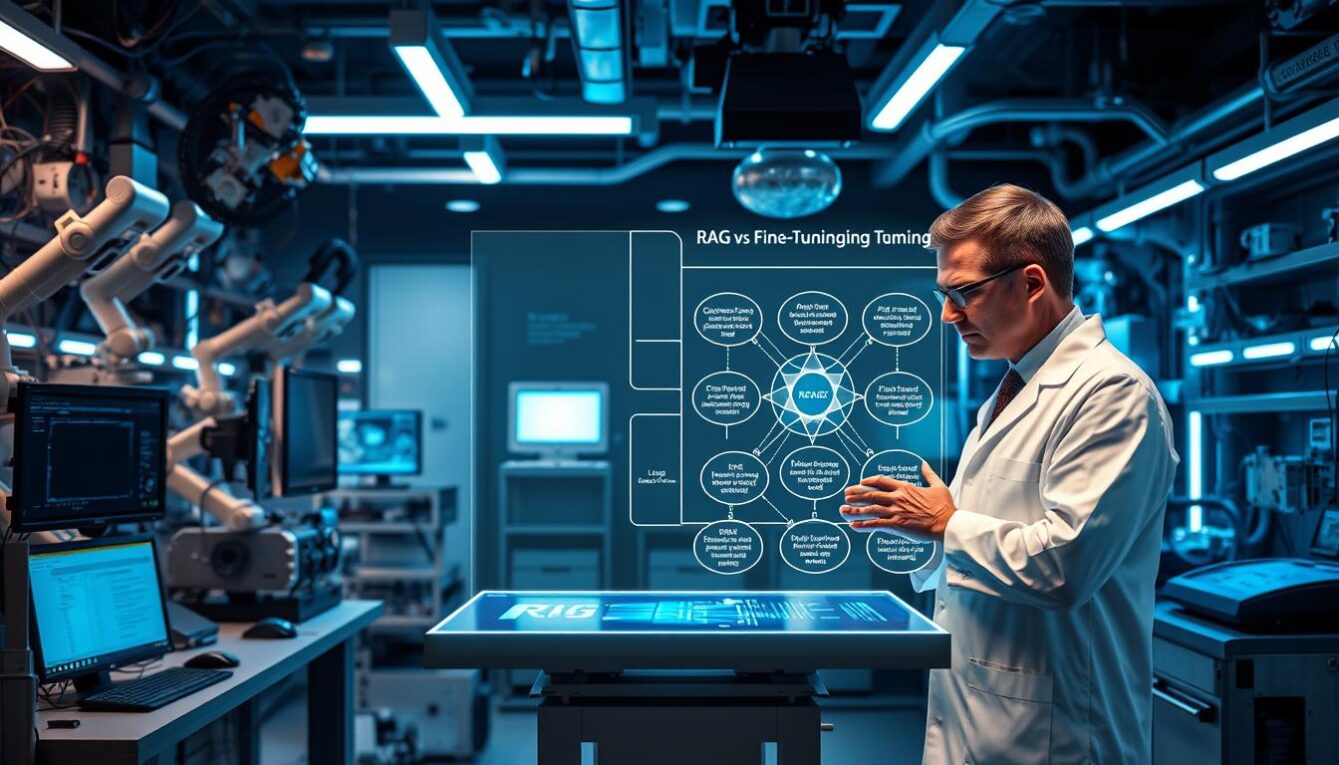I’m excited to share about Fine-Tuning and RAG in machine learning. These are key for better communication tech. A big 40% increase in tech companies using them shows how important they are.
Fine-Tuning and RAG are both important for LLM Customization. But they do different things. Fine-Tuning makes a model better for certain tasks. RAG adds new info to the model.

I want to help tech pros, business leaders, and buyers understand these new techs. This way, they can make smart choices.
Key Takeaways
- Knowing the difference between Fine-Tuning and RAG is key for LLM Customization.
- Fine-Tuning makes a model better for specific tasks.
- RAG adds new info to the model.
- Both are important for better communication tech.
- Choosing depends on what your project needs.
What is Fine-Tuning in Machine Learning?
Fine-tuning is a key method in machine learning. It helps make pre-trained models work better for specific tasks. This is done by adjusting the model’s settings to fit a new task or dataset.
Definition of Fine-Tuning
Fine-tuning means taking a pre-trained model and training it more on a smaller dataset. This way, the model learns new things while keeping its old knowledge. Fine-tuning is great when you have a small dataset, because it uses the model’s existing knowledge.
Importance of Fine-Tuning
Fine-tuning makes pre-trained models better for specific tasks. It helps them work more accurately and efficiently. This is very helpful when you don’t have a lot of data for a new task.
It also lets developers make models fit unique tasks. This makes fine-tuning very useful in machine learning. It helps use pre-trained models for many different tasks.
Popular Models for Fine-Tuning
Many pre-trained models are used for fine-tuning. BERT, RoBERTa, and CNNs like VGG16 and ResNet50 are popular. These models have been trained on big datasets and work well on many tasks. By fine-tuning them, developers can get top results for their tasks.
- BERT and its variants are great for natural language tasks.
- CNNs like VGG16 and ResNet50 are good for image tasks.
What is RAG (Retrieval-Augmented Generation)?
RAG is changing how we talk to machines. It mixes two big ideas: finding and making text. This mix makes models smarter and more helpful.
Definition of RAG
RAG is a new way to talk to machines. It uses two big ideas: finding info and making text. This way, RAG can give answers that are both right and up-to-date.
Key Components of RAG Models
RAG models have two main parts: a retriever and a generator. The retriever finds important info. The generator uses this info to make answers. This mix makes RAG models very good at giving answers.
Benefits of Using RAG
RAG is great because it gives real-time information and contextual responses. It can find the latest news in many areas. This makes it very useful for many tasks.
When RAG works with Large Language Models (LLMs), it gets even better. This makes it perfect for many uses, like answering questions and creating content.
The Relationship Between Fine-Tuning and RAG
Fine-Tuning and RAG work well together to make models better. Knowing how they work together helps make better machine learning models.
Together, Fine-Tuning and RAG make a strong team for model making. Fine-Tuning lets you tweak pre-trained models for new tasks. RAG adds real-time info, making the model smarter.
How RAG Enhances Fine-Tuning
RAG makes Fine-Tuning better by giving models a big, always-changing knowledge base. This means models can learn new things and get better at their jobs.
Key benefits of RAG in Fine-Tuning include:
- Access to real-time data, allowing models to stay current.
- Improved contextual understanding through the retrieval of relevant information.
- Enhanced model performance due to the incorporation of up-to-date knowledge.
Comparing Effectiveness in Tasks
Using Fine-Tuning and RAG together often gives better results than using one alone. Fine-Tuning is great for tasks needing detailed knowledge. RAG is best for tasks needing lots of current info.
In tasks like understanding language, Fine-Tuning makes models better at certain tasks. RAG helps models answer questions by finding the latest info.
Integration Scenarios
There are many ways to use Fine-Tuning and RAG together. For example, in making chatbots, Fine-Tuning can make the model answer questions better. RAG keeps the chatbot’s info up to date.
By using Fine-Tuning and RAG together, developers can make models that are both smart and always learning. This leads to better and more useful machine learning.
Advantages of Fine-Tuning
Fine-Tuning is great because it makes models better and uses less resources. It’s very important in machine learning, especially for Large Language Models (LLMs).
Customization for Specific Tasks
Fine-Tuning lets you make LLMs work for specific jobs. It changes the model to fit certain tasks better. For example, it can make a general LLM good at things like understanding feelings in text or translating languages.
Task-specific customization helps businesses use LLMs in many fields. This is key for companies wanting to use AI without making new models from scratch.
Improved Model Performance
Fine-Tuning also makes models better by learning from specific data. This makes the model smarter and more accurate. It can give better answers in real life.
Studies show Fine-Tuning makes models way better than not fine-tuning them. Here’s a table showing how much better they are in different tasks.
| Task | Non-Fine-Tuned Model Accuracy | Fine-Tuned Model Accuracy |
|---|---|---|
| Sentiment Analysis | 80% | 92% |
| Language Translation | 75% | 88% |
| Text Summarization | 70% | 85% |
Efficiency in Resource Usage
Fine-Tuning is also good because it uses less resources. It builds on pre-trained models, so you don’t need as much computer power or data. This is great for companies with not much to spend.

Also, Fine-Tuning works well even with little data. This makes it cheaper for businesses. It’s especially helpful when getting data is hard or expensive.
Benefits of RAG Integration
RAG integration brings many benefits to machine learning models. It lets these models use outside info to get better. They can give more accurate and useful answers.
Access to Real-Time Information
RAG integration is great for getting the latest info. This is key in areas like news, finance, and social media.
- It keeps models up-to-date with new info.
- It makes answers more accurate with fresh data.
- It helps models handle urgent questions better.
Improved Contextual Responses
RAG integration helps models understand context better. They can give more relevant and clear answers. This is because they can get info from outside sources.
Key benefits include:
- They understand context better.
- They give more accurate and relevant answers.
- Users get a better experience with answers that fit the context.
Broadening Model Knowledge Base
RAG integration also makes models smarter by giving them lots of outside info. This is super helpful for things like answering questions and teaching.
By adding RAG to machine learning models, developers make apps that are smarter and more helpful. These apps meet many different user needs.
Limitations of Fine-Tuning
Fine-Tuning is a great way to make LLMs better. But, it has its own challenges. Knowing these limits helps us use Fine-Tuning to its fullest.
Potential Overfitting Issues
One big problem with Fine-Tuning is overfitting. This happens when a model learns too much from the data it’s trained on. It then can’t handle new data well.
To avoid overfitting, we use regularization and early stopping. Regularization makes the model simpler. Early stopping stops training when the model starts to do worse on new data.
Data Requirements
Fine-Tuning needs lots of good data to work well. The data must match the task or area the model is for. Bad data can make the model worse.
Getting and preparing this data is hard. It takes a lot of time and money. This is especially true for areas with little data or hard data to prepare.
Time and Resource Constraints
Fine-Tuning big models takes a lot of computer power. This can be a problem for those without the right tools.
It also takes a long time. This can slow down how fast we can use the model.
Limitations of RAG
RAG has its downsides, like being complex and needing lots of data. It’s great in some ways, but knowing its limits is key for good use.
Implementation Complexity
Setting up RAG is hard. It needs a lot of tech know-how, for both getting and making data. This makes it take longer and cost more.
Key challenges in RAG implementation include:
- Designing an effective retrieval mechanism that can efficiently fetch relevant information.
- Ensuring seamless integration between the retrieval and generation components.
- Optimizing the overall system for performance and accuracy.
Dependence on Quality Data Sources
RAG’s success depends a lot on the data it uses. Bad data means bad answers. So, it’s important to use good data and keep it up to date.
The importance of data quality cannot be overstated, as it directly impacts the reliability and accuracy of the generated responses.
Performance Variability
RAG’s results can change a lot. It depends on the task, the data it was trained on, and the question’s complexity. Sometimes, it might not get it right.
To fix this, test RAG on many tasks and adjust it when needed.
Practical Applications of Fine-Tuning and RAG
Fine-Tuning and RAG are very useful in many areas. They help make things better in different fields. This shows how they can lead to new ideas and improvements.
Use Cases for Fine-Tuning
Fine-Tuning is great for making Large Language Models (LLMs) better for certain tasks. It’s very useful for sentiment analysis. This means models can understand how people feel about things, helping companies get better.
It’s also good for language translation. By making LLMs learn from certain languages, they can translate better. This helps people talk to each other across different languages and cultures.
Use Cases for RAG
RAG is best for getting real-time information. For example, in chatbots, RAG helps give the latest answers. This makes talking to chatbots more helpful and accurate.
RAG is also great for research and development. It helps find important documents and data fast. This makes research go quicker and helps find new ideas.
Case Studies in Industry
Many industries are using Fine-Tuning and RAG to improve. In healthcare, Fine-Tuning helps make models that can diagnose diseases well. RAG keeps up with new medical studies.
“The integration of Fine-Tuning and RAG has revolutionized our approach to customer service, enabling us to provide more accurate and personalized responses.” –
In summary, Fine-Tuning and RAG have many uses and are getting more useful. By using them, companies can stay ahead and create new things.
Future Trends in Fine-Tuning and RAG Integration
Machine learning is getting better, and Fine-Tuning and RAG are leading the way. We will see big changes soon. These changes will come from new ways to build and train models.
Emerging Innovations
New methods are being created to make Fine-Tuning and RAG better. These new ideas will help models understand things better. This will help them work well in many areas.
Industry Adoption Predictions
More companies will use Fine-Tuning and RAG soon. They will use these tools to get ahead. A good guide on how to use them will help companies stay ahead.
Addressing Ethical Considerations
As Fine-Tuning and RAG grow, we must think about their ethics. We need to make sure they are used right. This means fixing any unfairness and being clear about how AI makes decisions.










